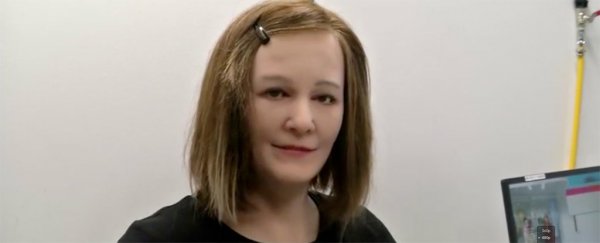What will robots look like in the future? Will they retain obvious signs of their artificial nature, or will they seamlessly blend in with people to such an extent that we might have difficulty telling them apart from living, breathing humans?
If Nadine – a new social and 'emotionally intelligent' robot from scientists in Singapore – is a sign of things to come, realistic-looking humanoid machines might just have the edge over their obviously artificial counterparts. How come? Because the physical resemblance to ordinary people could help us interact with a machine in a more natural way, whether at home, at work, or even if it were to look after us when we get old.
"Over the past four years, our team at [Nanyang Technological University] have been fostering cross-disciplinary research in social robotics technologies," said Nadia Thalmann, "to transform a virtual human, from within a computer, into a physical being that is able to observe and interact with other humans."
By employing linguistics and psychology in addition to conventional robotics fields such as engineering and computer science, the researchers have sought to blur the distinction between human and machine. Nadine – which is designed to look like a physical doppelgänger of a younger Thalmann – isn't exactly meant to fool us into thinking it's a real woman, but it's supposed to help us relate to 'her' as if the robot were any other ordinary person.
"This is somewhat like a real companion that is always with you and conscious of what is happening," said Thalmann. "So in future, these socially intelligent robots could be like C–3PO… with knowledge of language and etiquette."
With soft skin and fairly convincing-looking hair, Nadine is a pretty eerie emulation of an actual person, especially when the face is moving, as you can see in the video above. Of course, those vacant eyes could use a little work, and the robot's static, empty look in between actions gives away that this isn't a real person.
Still, these are the kinds of things the researchers are working on, and if some of Nadine's obvious 'tells' can be eroded, it's possible that people interacting with the robot would be more at ease, rather than less. Especially when it's programmed with a sense of personality and 'emotions', and is designed to remember you and details of previous conversations.
Nadine currently acts in the role of a 'receptionist' at Nanyang Technological University – a calling we've seen other, somewhat more conspicuous robots fulfil. But according to the researchers, this kind of technology could make the most sense as domestic companions in the home, especially for those who need help in caring for themselves.
"As countries worldwide face challenges of an ageing population, social robots can be one solution to address the shrinking workforce, become personal companions for children and the elderly at home, and even serve as a platform for healthcare services in future," said Thalmann.
If you've seen the TV show Humans, you'll have an idea of what that kind of system could look like. It might be a little while before robots like Nadine are as convincing as Humans' 'synths', but that day definitely looks like it's getting closer.
